
- •2. Steel
- •4. Properties of engineering materials and methods of testing them
- •1. Chipping metal and chipping tools
- •2. Metal-cutting and locksmith's cutting tools
- •3. Filing and filing tools
- •4. Mechanical tools
- •5. Measuring tools and devices
- •1, 2, 3, 8 -Jaws; 4 - adjusting screw; 5 - primary scale; 6 - depth rod;
- •6. Machine-cutting tools
- •7. Drills and drilling
- •8. Threading tools
- •9. Methods of holding tools between centres
- •10. Holding work in a chuck
- •II. Holding work in a vice
- •Chapter III machine parts
- •1. Welding
- •2. Induction brazing and soldering
- •3. Threads
- •4. Gears
- •5. Belt and chain drives
- •6. Bearings
- •7. Clutches
- •Chapter IV metal-cutting machines
- •1. Lathes
- •2. Drilling machines
- •3. Milling machines
- •4. Planers
- •5. Shapers and slotters
- •6. Grinding and grinding machines
- •Chapter V texts for home reading
- •1. The russian metallurgist d. K. Chernov
- •2. Oxygen in the bessemer converter
- •3. Oxygen enrichment in the blast furnace
- •4. Oxygen for direct reduction of iron ore
- •5. Crucible furnace
- •6. Portable hardness tester
- •7. High-speed precision ball bearing testing machines
- •Составные предлоги
- •Сокращения
- •Англо-русский словарь
5. Measuring tools and devices
A. MEASUREMENT
The size and shape of all machine parts should be in accordance with the corresponding drawing. The produced parts should be checked by means of measurement, which generally involves comparison either with some accepted standard or with a mating part. The significance of any measurement is determined by the degree of accuracy to which the parts may be measured.
Depending on measurements different measuring tools can be used such as rules, slide gauges, vernier calipers, depth gauges, dial indicators, micrometers, clearance gauges, inside and outside calipers, plug gauges, bevels, universal protractors, etc.
B. MEASURING TOOLS
When accurate measurement of the part is required, the vernier calipers, micrometers and slide gauges are used. When it is not so important to have an accurate measurement of the part, metal rules, inside calipers and outside calipers will do.
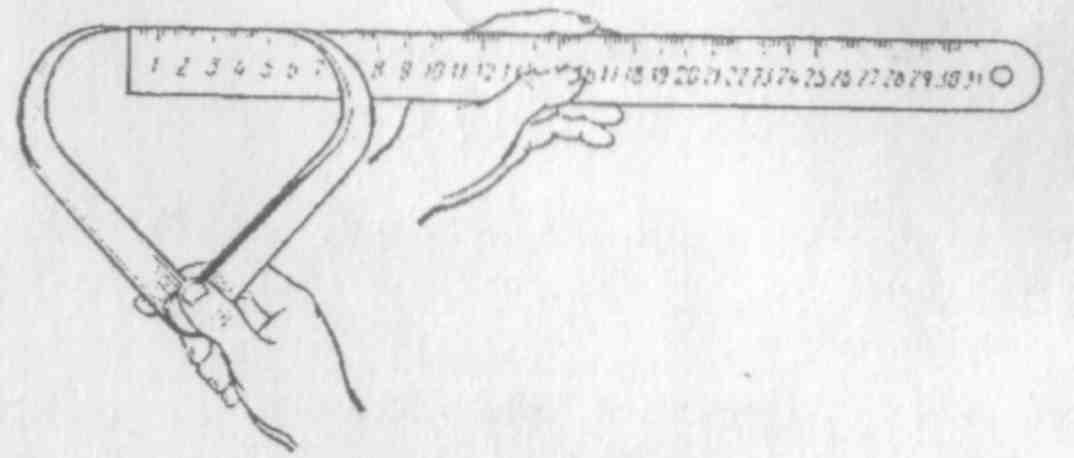
Fig. 11. Steel Rule
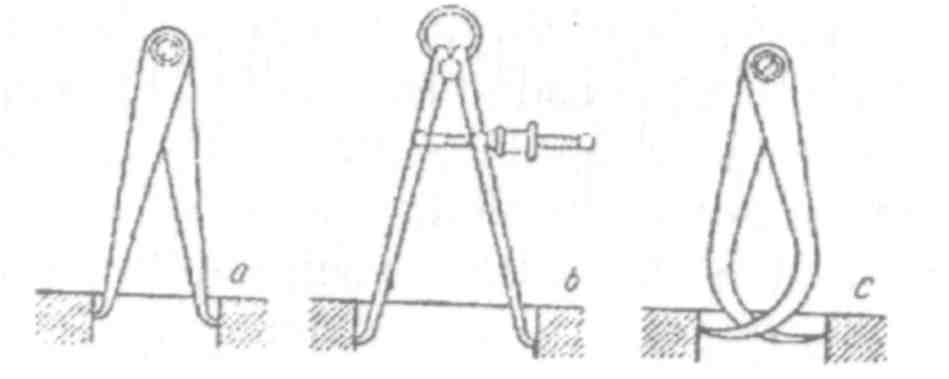
Fig. 12.Calipers:
a-inside; b-spring; c- outside
Steel rules (Fig. 11) serve for determining the length and sometimes the depth of the part to be measured. Steel rules are graduated in millimeters, but in the USA and England they are graduated in thirty-seconds and sixty-fourths of an inch1.
The outside (Fig. 12) calipers are the simplest instruments for measuring external diameters of the part. The outside caliper consists essentially of two curved legs.
The inside calipers are used for determining the internal diameters of the part. Its construction is almost similar to that of the outside calipers. Sometimes the outside calipers may be used for measuring internal diameters of the part. The outside and inside caliper measurements may be read by placing the legs of the calipers on a rule and placing one leg and the end of the rule against a flat surface as shown in Fig. 11.
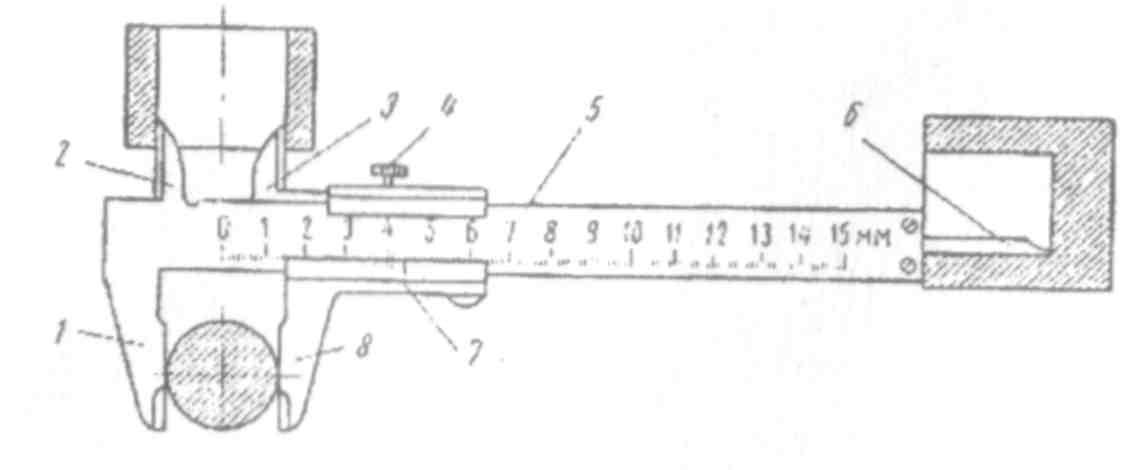
Fig. 13. Vernier Calipers:
1, 2, 3, 8 -Jaws; 4 - adjusting screw; 5 - primary scale; 6 - depth rod;
7 - frame with vernier

Fig. 14. Micrometer:
1 - frame; 2 - anvil; 8 - spindle; 4 - lock nut; 5 - barrel;
6 - thimble; 7 - ratchet thimble
Vernier calipers (Fig. 13) can be used for measuring both external and internal sizes of a part. By using vernier calipers measurements up to .001" may be
determined. Vernier calipers consist of a primary steel scale and four jaws. Jaws 1 and 2 are integral with the scale. Jaws 8 and 8 are attached to the frame sliding along the scale. The frame may be clamped on the scale in any position by means of an adjusting screw. External surfaces may be measured with jaws 1 and 8, while internal surfaces are measured with jaws 2 and 8. The depth of recesses is measured with a depth rod 6. A vernier on the frame 7 serves for measuring fractional parts of a millimeter.
The micrometer (Fig. 14) is an instrument for precise measurement of length and thickness of a part to one ten thousandth of an inch. The principle of operation is similar to that of vernier calipers. A graduated thimble serves as the primary scale. The scale on the barrel of the micrometer is used for the vernier reading. The part to be measured is placed between the anvil and micrometer screw, which is called a "movable spindle". By rotating the thimble, the spindle is removed or approached to the anvil. By rotating the ratchet thimble the spindle is moved and thus the part is pressed to the anvil. Thereupon the rotation of the ratchet thimble is discontinued, the micrometer opening is fixed by the lock nut and the reading is taken. The micrometer reading is the sum total of the barrel divisions, the thimble divisions with respect to the axial line on the barrel, and the vernier reading.

Fig. 15. Dial Indicator: I - dial; 2 - indicator pointer; 3 - test point
Fig. 15 shows a dial indicator. The dial indicator is a gauge with a graduated dial and an indicator pointer connected to a test point by a system of levers. Any movement of the test point is magnified by the indicator pointer. The dial indicator is used to check the shape of a part., the precision of its machining, as well as for checking the accuracy of cutting machines.
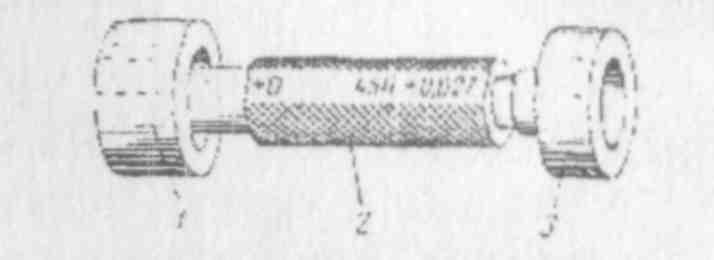
Fig. 16. Go and No-Go Plug Gauge:
1 - go plug gauge; 2 - handle; 3 - no-go plug gauge
Thread plug gauges or internal gauges, being of "go" and "no-go" type (Fig. 16), are generally used for testing threads or tapped holes.
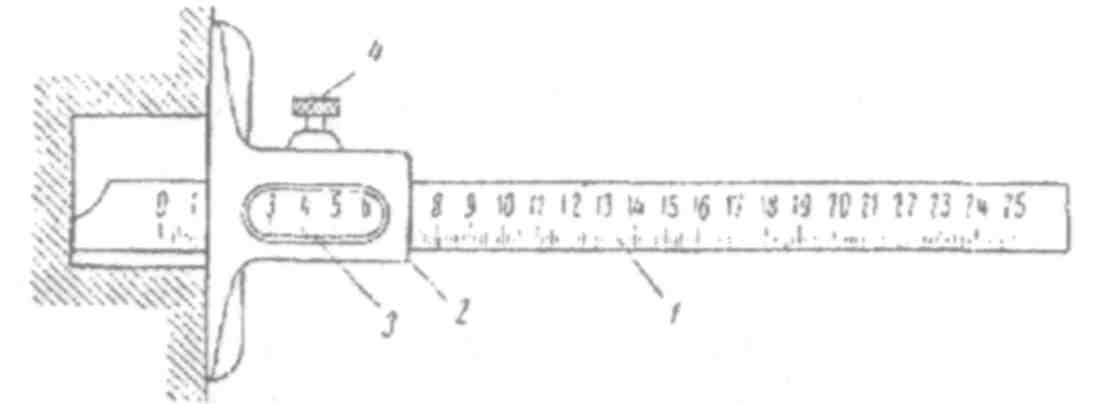
Fig. 17. Depth Gauge:
1 - primary scale; 2 - frame; 3 - vernier; 4 – screw
Depth gauges are used for measuring the depth of grooves and holes. Their principle of operation is similar to that of vernier calipers. A primary scale sliding in a frame may be locked in any position by a screw. The depth of a groove or a hole is measured by means of the primary scale and a vernier as shown in Fig. 17. Conical surfaces are measured with control gauges.
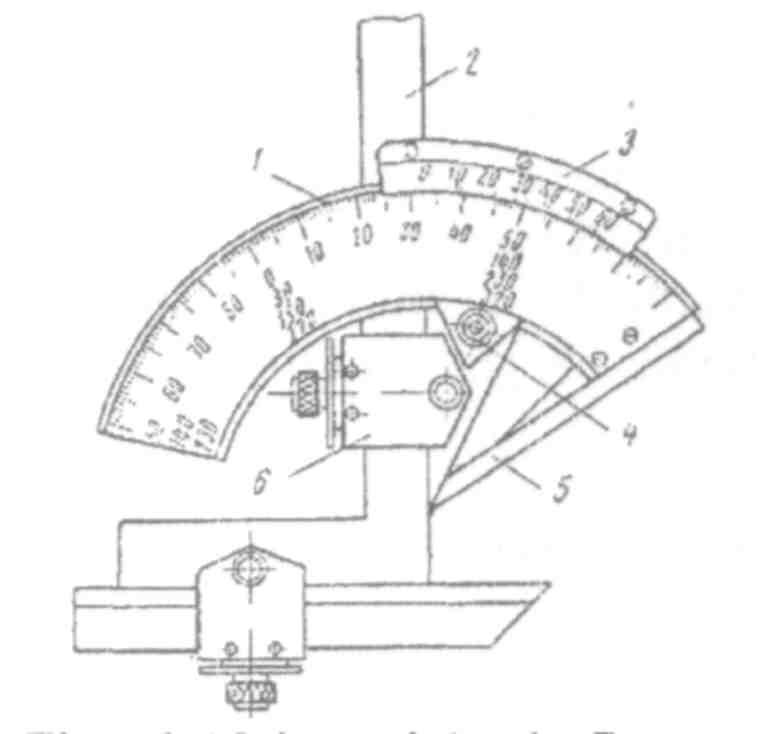
Fig. 18. Universal Angle Gauge:
1 - base; 2 - triangle; 3 - vernier; 4 -quadrant; 5 - detachable rule; 6 - holder
A universal angle gauge for measuring internal and external angles is shown in Fig. 18. The universal angle gauge consists of a base with a primary scale attached to the base. A quadrant with a vernier may be moved along the arc of the base. A triangle may be attached to the quadrant by means of a holder. In its turn a detachable rule is attached to the triangle. The triangle and the detachable rule can be moved along the face of the quadrant. Angles can be measured within the range of 0° to 320° by means of the universal angle gauge.

1. they are graduated in thirty-seconds and sixty-fourths of an inch - они градуируются в тридцать вторых или шестьдесят четвёртых дюйма.
Exercises
I. Use the following words and phrases in sentences of your own:
drawing, to measure, to involve, mating part, accuracy, slide gauges, vernier calipers, depth gauges, clearance gauges, micrometer, inside calipers, outside calipers, to graduate, internal diameters, to slide, adjusting screws, lock nut, tapped hole
II. Translate the following groups of words, paying attention to the meaning of suffixes:
to measure, measuring, measurable, measured, measurement; to compare, comparative, compared, comparison; to signify, significant, significance; to depend, depending, dependence, dependent; to graduate, graduated, graduation; accuracy, accurate; precise, precision; general, generally, generation
III. Supply synonyms for the following words:
to place, inside, outside, to be similar, according to, with reference to
IV. Fill in the blanks with prepositions in accordance with, by means of, within, for, to, of:
1. Machine parts should be manufactured... their respective drawing. 2.... a micrometer it is possible to make measurements to a very high degree of accuracy. 3. Calipers are used for measurements to ... 0.18 mm. 4. Measuring tools should be chosen ... the machine part to be measured. 5. The micrometer is an instrument ... measuring directly ... thousandths, and estimating to quarter thousandths an inch, ... its range.
V. Translate the following sentences observing different meanings of the words in italics:
1. The principle involved in the operation of the micrometer is explained in technical text-books. 2. The instruction on the use of this dial indicator is rather involved. 3. These drawings and their explanations are given to illustrate the principles involved. A. Different kinds of instruments are used to measure holes of considerable depth. 5. A millimeter is a measure of length. 6. Steel plates usually vary by sixteenths of an inch. 7. By dividing the load required to break the specimen by its area, the ultimate tensile strength of material is obtained. 8.By accuracy of form is meant not only the exact duplication of irregular pro files, but also the accuracy of form embodied in squares, true cylinders, cones, etc.
VII. (a) Translate the following text using a dictionary:
A range of optical instruments for measuring surface finish, which are relatively inexpensive and of very robust design, and afford the advantage that they can readily be applied under both workshop and inspection-room conditions, is being produced by many plants. Known as optical devices, these units are of modern designs. The portable device is intended for checking the relatively coarse finishes produced by planing, turning, and milling. With this device a beam of light
is directed past a straight, opaque edge, and through a lens at an angle of 45' to the work surface, and the line of intersection is observed at an angle of 90° to the light beam, through the eyepiece of the microscope.
(b) Make up three questions on the basis of this text and answer them.
VIII. Make up questions concerning the measuring tools shown in Figs 11, 12 and answer them.
IX. Using the following words and word combinations describe the principle of operation of the vernier calipers shown in Fig. 13:
vernier calipers, to be used, to measure, external and internal sizes, a part, to consist of, steel scale, four jaws, two jaws, to be attached, the frame, to slide, the scale, the first two jaws, to be used, measuring external surfaces, the Other two jaws, measuring internal' surfaces, the depth, to be measured, a spindle
X. Giving answers to the following questions describe the principle of operation of the micrometer shown in Fig 14:
1. What is a micrometer? 2. What is the function of the graduated thimble of the micrometer? 3. What is the scale on the micrometer barrel used for? 4. Where is the part placed for measurement? 5. How is the part pressed to the anvil and how is the micrometer reading taken?
XI. Describe the measuring tools shown in Figs 15, 16, and 18.
